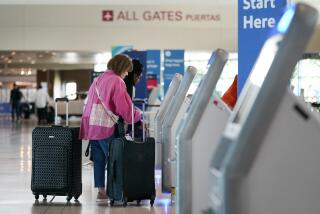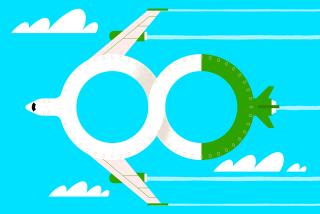When you’re not flying on the airline you think you’re on
- Share via
IT was a hot day in mid-August when Michael and Joyce Ludmer of Westwood arrived at Rome’s Fiumicino Airport for a Lufthansa flight to Catania, Sicily. The Ludmers went to the domestic terminal for their flight and headed to the Lufthansa desk to check in.
Only problem: There was no Lufthansa check-in desk.
Puzzled, they asked a nearby airport employee who said what sounded to them like “Area One” so they looked for Area One -- in vain.
Their concern growing, they asked another airport employee, who helped solve their problem.
“We spent a frenzied half-hour ... in search of Lufthansa’s check-in counter until discovering that the actual carrier was Air One,” Michael wrote in an e-mail to The Times.
Nowhere on their printed ticket was Air One mentioned, nor was it on the itinerary their travel agent provided them. The Ludmers had very nearly been tripped up by what might best be called “code-share confusion.”
“Code share” means that tickets are sold by one airline for a seat on a code-share partner’s airplane, a growing trend in the industry.
“I don’t think a week goes by without somebody announcing a new code-share agreement,” said Henry Harteveldt, vice president and travel industry analyst with Forrester Research, a Cambridge, Mass.-based market research firm. The most recent pairing? American Airlines and Malev Hungarian Airlines, hardly a household name for American travelers.
For consumers, the trend has benefits and drawbacks.
At their core, airline code shares are really just marketing agreements that allow airlines to sell flights to destinations they otherwise might not serve or to customers they might not otherwise reach. A code-share flight on United to Charlotte, N.C., for example, will probably be operated by United’s code-share partner US Airways.
This type of agreement gives United broader access to the market and provides US Airways with access to United’s customers.
And consumers can earn frequent-flier miles with their preferred carrier and book using their airline’s website, which may be familiar to them. They may also get such frequent-flier perks as pre-boarding and international lounge access.
Department of Transportation regulations require carriers to “tell consumers clearly when the air transportation they are buying or considering buying involves a code-sharing arrangement.” But the word “clearly”? Therein lies the rub.
For travelers with electronic tickets and printed itineraries, the airlines do a pretty good job of explaining that while a flight might have airline A’s flight number, the actual flight is operated by airline B. For the minority of travelers these days who carry paper tickets, it’s not always as clear.
“An e-ticket does show clearly the selling and the operating airline,” said Kathryn Hayden, spokeswoman for Sabre Travel Network, one of the global distribution systems for airline tickets.
I searched for flights to Catania from Los Angeles using the United Airlines website. The first leg of the flight was United 8861 to Munich, Germany, which was actually a Lufthansa flight. The next leg was a Lufthansa flight number that really was a Lufthansa flight. The final leg was a Lufthansa flight number (the same one the Ludmers were on) but operated by AP, the airline code for Air One -- not a very intuitive code. (If you have a question about an airline code, go to www.airportcitycodes.com and click on “Airline Codes.”)
If a traveler had checked in with the airline indicated by the flight numbers, he would have been in the wrong place two out of three times. Travelers with electronic ticket itineraries need to pay attention to the “operated by” parts of their itinerary. That is the airline they should check in with.
Ninety-five percent of tickets issued in the U.S. these days are electronic, Hayden said. But that number drops to just 70% of all tickets issued worldwide. That means international travelers need to be extra vigilant because the only airline information on a printed ticket is often that of the airline that sold it. That’s what the Ludmers encountered in Rome.
“If it’s an e-ticket, [the operating airline] is indicated,” said Lufthansa spokesman Alex Schmidbauer. “On a paper ticket, it is not.”
Though Schmidbauer said Lufthansa was not changing its paper ticket policy, he said he was contacting colleagues in Rome to see whether some sort of signage could be arranged and offered to provide the Ludmers some sort of compensation for their trouble. (They declined.)
“It is starting to become a problem,” said Terry Trippler, an airfare expert with MyTravelPassport.com. “People are going to be missing flights. I’m hearing of more and more of it.”
Some relief may be on the way.
“Our newer ticket stock also provides the operating carrier on the ticket,” said Sabre’s Hayden.
Here are some tips to help navigate the ever-more interconnected world of code-share flights:
If you have an electronic ticket with a printed itinerary: Check in at the airline that is listed as the “operated by” airline. If there is no “operated by,” it’s safe to assume that the airline that sold you the ticket will be the airline you are on.
If you have a paper ticket: Check the departure screen at the airport. Even if your airline is not listed there, your destination and time of departure should be. Then go to the gate that matches that information, even if it is a different airline from the one on your ticket.
If you are shopping for a flight: A flight booked through a code-share airline might be cheaper than the same flight booked directly with the airline. For example, the flight I looked at from Los Angeles to Catania booked on United’s website using mostly Lufthansa flights cost $802. (Fares are for comparison only and may no longer be available.) The lowest fare I could find on Lufthansa’s website for the same destination was $1,134.
Airlines will to themselves and their code-share partners a certain number of seats to sell at a low price. If the airline sells out its allocation of seats at the low fare (as Lufthansa did in this case), those fares may be available from a code-share partner (United in this case).
Contact James Gilden at www.theinternettraveler.com.
More to Read
Sign up for The Wild
We’ll help you find the best places to hike, bike and run, as well as the perfect silent spots for meditation and yoga.
You may occasionally receive promotional content from the Los Angeles Times.






